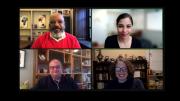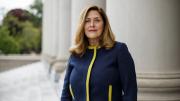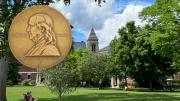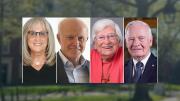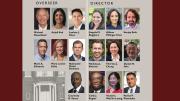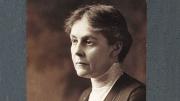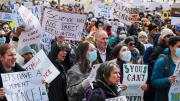“This work is doable. The family structures of the Harvard-affiliated slaves may be currently unknown, but they are not unknowable.” That was the message this week from Richard Cellini, director of the Harvard Slavery Remembrance Program, which in recent months began tracing the present-day descendants of people who were once enslaved by Harvard administrators, faculty, staff. “Our mission,” Cellini said, “is to help people recover their truth, one family at a time.”
Cellini was one of the speakers Tuesday evening during an online discussion organized to update Harvard community members on the work under way, funded by a $100 million endowment, to fulfill recommendations laid out in the Harvard and the Legacy of Slavery report, which the University released last year. Thompson professor of education and society Meira Levinson spoke about the project she is leading to develop educational tools and resources to help Harvard faculty and others teach the history revealed in the report. And Jerome Offord Jr., associate University librarian for antiracism, discussed a new partnership between Harvard Library and the HBCU Library Alliance, a consortium of more than 100 Historically Black Colleges and Universities (HBCUs).
Sara Bleich, vice provost for special projects, who is overseeing University efforts to implement the report’s recommendations, moderated the discussion. She offered an overview of the history and mission of the project as a whole, which she described as a work of “reparative justice.” And she noted one important theme underpinning all of it: “We are approaching this work with humility. We are really trying to listen hard. And we are looking for ideas from many, many different stakeholders about how we can really honor the work that we are trying to do.” In other words, she told the audience, “We are looking for your good ideas.”
Cellini, who previously founded and ran a research institute that helped Georgetown University identify descendants of enslavement, offered some details about the process involved. The work “involves a near small army of scholars and researchers to actually look into the archival record,” he said. “We don’t have to create a full biography, but we have to create enough particularity or specificity around an enslaved ancestor to make them a suitable subject for genealogical research.” His team uses what’s known as the Mayflower standard in proving genealogical lineage; it’s a widely recognized methodology that is also used to trace the lineage of the Mayflower passengers. The research relies on traditional archival evidence “at every link in the chain” of descent, Cellini said. “People often ask me, ‘What about DNA, or stuff on the internet or family oral histories?’” he said. “Those things are helpful, but they are helpful mostly—in fact, entirely—in pointing us back to the archival stacks.”
At Georgetown, he and his colleagues were able to find more than 10,000 direct descendants of the 314 people who were sold at auction by that university to secure its finances in 1838. Harvard’s report uncovered evidence of more than 70 people who were enslaved by faculty, staff, and leaders—including presidents—and on Tuesday Cellini said that number was likely to go higher. “We believe there are many, many more to be discovered from archival research,” he said. Already, he added, his team is making progress: “Dozens of Harvard enslaved ancestors have already been profiled, and a number of them are in active genealogical research.”
The Harvard report’s recommendations offer an abstract instruction to “support” descendants once they are identified, although the precise form that support will take has not yet been determined. At Georgetown, the administration expanded legacy admissions to include the direct descendants of those enslaved by the university and last year launched a $400,000 annual fund to support community-based projects that benefit descendants.
Responding to a question from Bleich about the significance of his work and the larger initiative it’s a part of, Cellini offered this reflection: “Those of us who have attended universities like Harvard or Georgetown or similar universities—or any university, for that matter—we all understand that we’re warming ourselves by a fire we didn’t build, and drinking from a well we didn’t dig,” he said. “But then somebody raises the question of, who did build that fire? Who did dig that well? To whom do we owe thanks and gratitude?” The answer to those questions is meaningful, he added, “because those people have historically been erased from the memory of Harvard.”
Offord, who leads Harvard’s half of a four-year, $6-million partnership with the HBCU Library Alliance, spoke a bit about the aims of and approaches to that work, which began this spring. The goal is to digitize and preserve African American history collections in HBCU libraries and archives, and also to expand access to that information for researchers, teachers, scholars, and the public. “These are just very rich collections,” Offord said, “that we believe the world needs to have access to.” In his presentation, he showed digitized photos from the early 1900s of homecoming queens with armloads of flowers and black-robed graduates holding their diplomas.
Offord and his team are still in “what we call the discovery and planning phase,” he said, “where we are building trust, building transparency, building rapport with the HBCU Alliance,” a consortium that includes more than 100 institutions. That trust and transparency is part of a recognition “that there has been harm done in the past” by Harvard. Offord, who spent seven years working at a historically black institution, Lincoln University of Missouri, before coming to Harvard, emphasized that the HBCU libraries his team is working with will maintain full ownership and control of their collections. “Harvard is not trying to acquire those materials,” he said. “We’re really just interested in the materials being available and exposed to the world.” In the coming weeks and months, Offord and his colleagues explained, they are working out a project plan and budget, hiring a program director, and forming an advisory group to help guide their activities.
For Levinson’s team, too, the work is still in relatively early stages. She noted that there is a self-guided walking tour available for computers and smartphones showing spots on campus that connect to Harvard’s enslavement history. Her team is also working to establish a book club reader’s guide for groups—an alumni organization, for instance, or an academic department— that want to read the report together and discuss it (this academic year, Harvard Divinity School chose the report as its “common read” for the year, holding a series of conversations that revolved around the findings).
Working with doctoral students and alumni, Levinson and her team have also been developing curricular resources for teaching, and expanding on, Harvard’s history of slavery and racism. Among the materials they’ve been working on is a series of case studies intended to help students and others “think about the values, the principles, the ethical quandaries” involved in the entanglements of enslavement at Harvard: not just the direct ownership of people—some of whom lived and worked on campus—but also the interwoven financial ties, donations from alumni enslavers, and scholarship by faculty members on scientific racism and eugenics. “Because this can be hard to talk about,” Levinson said, “and hard, especially, to discuss in a way that is complex and helps people understand… we’ve created these tools for conversation to help people think about, ‘What does this have to do with us?’ And ‘What do we expect of ourselves?’ What do we expect of our institution?’”
The first case study, now available online, is titled “A Forced Reckoning,” and deals with students learning for the first time about the work of nineteenth-century Harvard biologist Louis Agassiz, who popularized the theory of polygenesis, used to justify the enslavement of Africans and indigenous people. The case study includes questions and suggestions to help facilitate group discussion. Other case studies are forthcoming in the next few weeks, Levinson said: one about naming practices and principles at Harvard; another about universities’ land use and the effect on housing; and a third about the Rhodes Scholarship (named for Cecil Rhodes, the nineteenth-century mining magnate and imperialist who founded De Beers, which until recently dominated the world diamond market, and who governed the British colony that is now South Africa, where he helped establish a political structure that would later give rise to apartheid).
Later, answering an audience member’s question about what the effort to implement the report’s recommendations will look like in 10 or 20 years, Levinson talked about the importance of partnerships, like the ones Offord is building with HBCU libraries, and with students and educators to produce new curricular materials. “These have to be partnerships, true partnerships of equals,” she said. “That’s true for everything we’re doing…. None of us is the sole source of knowledge or wisdom, and we are not here to bestow it upon others. We’re here to work and learn together.”
